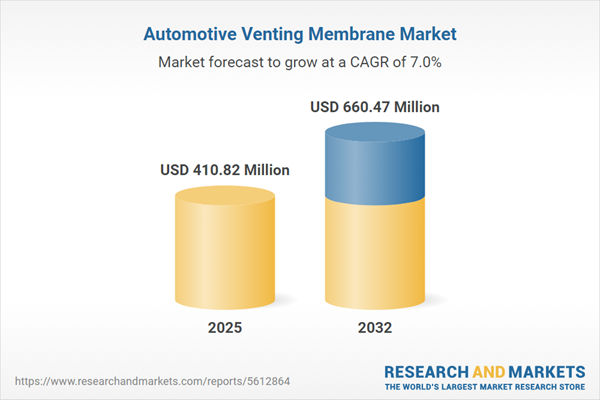Speak directly to the analyst to clarify any post sales queries you may have.
Amid accelerating vehicle electrification and evolving safety standards, senior automotive executives are prioritizing protective material strategies to safeguard operational reliability and regulatory compliance. Advanced automotive venting membranes are now instrumental in extending system lifespan and supporting robust supply chain integration across global markets.
Market Snapshot: Automotive Venting Membrane Market
The automotive venting membrane market is anticipated to expand from USD 384.37 million in 2024 to USD 410.82 million in 2025, ultimately reaching USD 660.47 million by 2032, reflecting a 7% compound annual growth rate (CAGR).
Key drivers include the need for efficient pressure equalization and enhanced filtration performance suited to both vehicle electronics and critical assemblies. The rapid adoption of vehicle electrification is prompting manufacturers to deploy innovative membrane technologies that strengthen durability and maintain compliance throughout the automotive product lifecycle. As the secondary automotive venting material market evolves, organizations must adapt material science and integration strategies to synchronize with increasingly complex regulatory frameworks.Scope & Segmentation: Automotive Venting Membrane Market
- Material Types: Expanded PTFE membranes, available in calendared and sintered forms, stand out for their superior resistance to chemicals and thermal extremes. Polyethersulfone (PES) and PTFE-coated variants, supported by custom backings, are adopted for their procurement flexibility and compatibility with automotive industry requirements.
- Application Areas: Venting membranes are deployed across crankcase covers, battery management systems, fuel delivery components, electronic modules, and transmission assemblies, advancing both functional reliability and safety benchmarks.
- Vehicle Types: These solutions extend from passenger vehicles to commercial fleets and heavy-duty trucks, ensuring operational consistency and resilience across diverse fleet operations and geographic regions.
- Distribution Channels: Partnerships with OEMs and aftermarket suppliers enable manufacturers to quickly respond to shifting market needs, ensuring dependable product delivery and procurement pathways.
- Regional Coverage: Significant growth takes place in the Americas, Europe, Asia-Pacific, the Middle East, and Africa. Focused development in markets including China, India, South Korea, and Japan ensures alignment with regional automotive standards and regulatory demands.
- Companies Profiled: Key participants include Pall Corporation, Parker Hannifin Corp., Donaldson Company, Inc., Porex Corporation, Prostech, Rogers Corporation, SABEU GmbH & Co. KG, Schreiner Group, Sterlitech Corporation, and Sumitomo Electric Industries, Ltd.—all maintaining a strong emphasis on technological advancement and international service capabilities.
Key Takeaways for Senior Decision-Makers
- The integration of advanced expanded PTFE and PES membranes elevates chemical resistance and supports robust performance under broad temperature ranges and demanding conditions, matching industry expectations for reliability and safety.
- Using precision calendaring and sintering processes allows membrane customization for next-generation automotive architectures, promoting seamless adoption of electrification strategies and new vehicle platforms.
- Microscale pore structures safeguard electric vehicle batteries and sensitive modules, directly meeting critical performance and safety requirements as electric mobility accelerates globally.
- Strategic supplier partnerships built on responsible resource management and ethical sourcing strengthen value delivery and reinforce global compliance obligations.
- Integrating digital quality assurance solutions enables rapid organizational response to regulatory and manufacturing changes, enhancing operational adaptability.
- OEM and aftermarket collaboration supports holistic certification, traceability, and inventory management, positioning enterprises for fast adaptation to future regulatory or market-driven shifts.
Tariff Impact on Sourcing & Supply Chains
Global tariffs on fluoropolymer resins are prompting automotive sector leaders to refine sourcing and supplier selection. By deepening manufacturing partnerships and optimizing logistics, industry stakeholders are developing resilient, compliant supply chains that can absorb new regulatory and market challenges.
Methodology & Data Sources
This analysis synthesizes input from material scientists, automotive engineers, and sourcing professionals at leading OEMs. Insights are drawn from technical documentation, patent repositories, peer-reviewed market research, and verified public sector datasets to ensure findings are practical for executive planning.
Why This Report Matters
- Detailed segmentation allows procurement and compliance leaders to align technical product selection seamlessly with operational and regulatory imperatives.
- Insight into global supply chain dynamics supports informed forecasting of tariff impacts and enhances supplier engagement strategies across key automotive regions.
- Thorough data validation methods support risk management and facilitate smooth execution of complex market entry or repositioning plans.
Conclusion
This report equips senior automotive leaders with actionable intelligence to refine venting membrane selection, advance quality assurance, and optimize procurement in a sector shaped by rapid technical and regulatory transformation.
Additional Product Information:
- Purchase of this report includes 1 year online access with quarterly updates.
- This report can be updated on request. Please contact our Customer Experience team using the Ask a Question widget on our website.
Table of Contents
3. Executive Summary
4. Market Overview
7. Cumulative Impact of Artificial Intelligence 2025
Companies Mentioned
The companies profiled in this Automotive Venting Membrane market report include:- Pall Corporation
- Parker Hannifin Corp.
- Porex Corporation
- Prostech
- Rogers Corporation
- SABEU GmbH & Co. KG
- Schreiner Group
- Sterlitech Corporation
- Sumitomo Electric Industries, Ltd.
- Donaldson Company, Inc.
Table Information
| Report Attribute | Details |
|---|---|
| No. of Pages | 189 |
| Published | October 2025 |
| Forecast Period | 2025 - 2032 |
| Estimated Market Value ( USD | $ 410.82 Million |
| Forecasted Market Value ( USD | $ 660.47 Million |
| Compound Annual Growth Rate | 7.0% |
| Regions Covered | Global |
| No. of Companies Mentioned | 11 |









